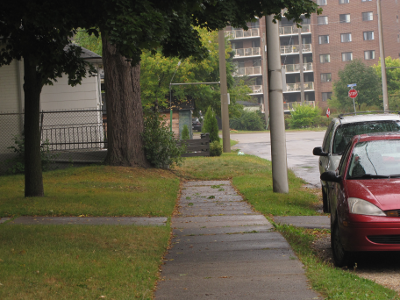How the University of Waterloo fails its pedestrians

Missing sidewalks are in blue, access roads that are used as paths are in red, and orange indicates unpaved or inadequately distinguished paths. (The image links to the detailed view on Google Maps.)
The University of Waterloo’s main campus was built in the 1960s, and it shows badly. The campus is designed with a strong car focus, despite UW being a university with extensive pedestrian traffic. I’ll leave further discussion of the problems of UW’s suburban form to a future post, and restrict this one to existing pedestrian issues.
How does the University of Waterloo fail its pedestrians? It often provides sidewalks on only one side of a road or sidewalks that are too small. Many main paths are not paved and encounter obstacles such as parking lots, man-made berms, poor or absent crosswalks, and, of course, weather conditions. UW forces pedestrians onto access roads designed for cars that make those on foot feel distinctly unwelcome. Instead of using more appropriately-sized vehicles, it uses regular vans and SUVs (maintenance, police, delivery, access vehicles) right on major pedestrian thoroughfares. Many buildings connect poorly to their surroundings, with few access points and several buildings actually surrounded by something resembling moats. The university is difficult to get in and out of, with poor connections to an existing path network and missing sidewalks on major roads (Westmount Road and Seagram Drive), as well as on the within-campus Ring Road itself. The adjacent shops on University Avenue surround busy parking lots and are frankly hostile to pedestrians, despite the vast majority of customers being pedestrians.
There are additional issues for cycling and handicapped access, such as excessive use of stairs, man-made topographic obstacles, mismatched or absent curb cuts, and so on.
In the map above, I’ve tried to point out most of the problematic sections around UW, excepting the significant additional troubles of ongoing construction. Below are a few photos I took this week that give a feel for the kinds of problems pedestrians face on the University of Waterloo’s main campus. UW does have many portions that work fine for walking, but that is no excuse for its failures. Read More…
Good ideas: Permeable pavement
Most pavement is impermeable to water. As a result, paved surfaces need to be designed to funnel water into drains, and drainage and sewer systems need to be designed for the high capacity necessary to deal with runoff from the huge number of paved surfaces in our cities. Instead of replenishing groundwater, precipitation is redirected to rivers and lakes. Runoff from roads carries with it automotive pollution, which is then concentrated in downstream bodies of water.
Various technologies are coming into use, however, for pavement that is permeable to water. Porous asphalt and pervious concrete are fairly new techniques, so they are still being developed and improved. The main difficulties include weight resistance and longevity, as well as cold climate installation. And, of course, it’s more expensive to install (particularly for cold climates), though it may be cheaper than conventional pavement if considered together with the costs of storm-water management.
What’s the point? First off, urban runoff is reduced, and with it pollution and the need for large and extensive drainage systems. But there are other benefits that I haven’t seen mentioned elsewhere. On impervious road surfaces drainage can work poorly, leading to the sometimes hazardous accumulation of water, which could be averted by permeable pavement. Likewise, it can prevent the ubiquitous puddles that form in depressions on sidewalks and paths. This pavement can also eliminate the need for drainage grates that are often encountered on bike lanes, which can be a hazard and nuisance to cyclists. If pervious concrete is used, it has the added advantage of reflecting more sunlight than asphalt, which can have a significant mitigating effect on climate change.
The technology is promising and I am surprised that the Region of Waterloo hasn’t yet taken up the idea. The Region should investigate permeable pavement and at least pilot the technology. They could do worse than paving the path through Waterloo Park as a test.
Missing sidewalks in Kitchener-Waterloo

For a city to be open to pedestrians, there need to be paths between useful destinations, the paths need to be maintained, and pedestrians need to feel safe. Before you can run, you have to walk, and before you can walk, you need a place to do it. In Kitchener-Waterloo there are numerous roads that are missing sidewalks, often on both sides of the street. Sometimes the sidewalks are sporadic: they appear and disappear on a stretch of road. Occasionally one-sided sidewalks even switch sides at intersections. Suburban subdivisions are haphazard, sometimes having full sidewalk coverage, but just as often leaving them out. And sidewalks in industrial areas are simple: there just aren’t any.
I set out to document the state of missing sidewalks in Kitchener and Waterloo. Using Google Maps, I drew red lines for roads missing sidewalks on both sides and blue lines for those missing a sidewalk on just one. I tried to cover everything that is not a suburban subdivision, and I did Eastbridge as an example of a suburban area. There are undoubtedly missing sidewalks that I did not document, and probably some tiny sidewalks that I mistook for curbs. Click on the below map image to see it on Google Maps in more detail. [Update: This is based on 2006 satellite imagery, and a few sidewalks have been put in since then.] Read More…
A walk from Waterloo to the University of Waterloo
Waterloo is a small city that has owed much to the rise of the University of Waterloo over the last half century. Uptown Waterloo is the thriving, if small, downtown area. Waterloo has 100,000 residents and the University of Waterloo has 30,000 people. It’s less than 2 km between Uptown and the main UW campus. Let’s take a walk from one to the other.
